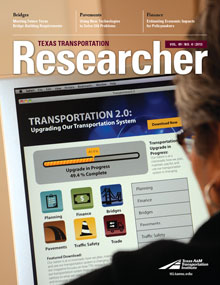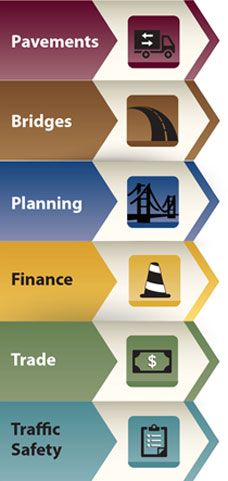
Agency Director
If you think about it, our transportation system is a lot like a computer system. Both connect users to things they need: goods, services, education, leisure activities, even employment. Both depend on robust technology to facilitate user access. And both are eventually limited by what, at one time, seemed like the most advanced performance possible.
You know it’s time to update the old computer when it no longer meets your needs. Traffic congestion, aging infrastructure, high maintenance costs: these are a few characteristics of our current transportation system. If our system were a computer, you might be tempted to say, “It’s time for an upgrade.”
This issue of the Texas Transportation Researcher looks at how the Texas A&M Transportation Institute (TTI) is helping upgrade our transportation system to the next level of operability. Whether it’s a new invention or a new method for performing an old task, technology is driving that change. Advanced maintenance techniques, innovative applications in traffic safety, longer-lasting construction materials and state-of-the-art planning software are a few examples of how new technologies and tech-dependent applications are essential to making this transition successfully.
TTI research is playing a key role in developing these innovations. We assist local governments with online surveys to capture data detailing how the community is using its transportation system. Our researchers apply advanced modeling software to assist regional planning groups in finding the most effective, cost-conscious solutions to local mobility problems. In the maintenance area, the Institute continues to lead in the development of longer-lasting, better-performing road materials and application techniques. In terms of fostering economic growth, TTI is helping to increase the efficiency of Texas-Mexico border crossings to facilitate international commerce. And to help keep travelers safe, Institute researchers designed and helped deploy a unique warning system to alert travelers of upcoming congestion, thereby reducing the chance for rear-end collisions.
These kinds of advances are important, but without communication, great ideas can die on the vine. The Institute’s involvement in the Transportation Research Board (TRB) of the National Academies has helped us share the results of TTI research across the country and around the world. TTI researchers participate in TRB‘s annual meeting and are members of — and sometimes lead — TRB committees. To honor that long-standing relationship, we profile our association with TRB in this issue.
It’s important to realize that nearly every aspect of what makes our transportation system a cohesive whole is at a crossroads: from how we fund the system to how we operate and maintain it to how we interact with our vehicles. (Have you heard of the self-driving car? It’s already street legal in California.) The system built over the past 60 to 70 years has done a great job, even with some flaws, like the delays we experience in rush-hour traffic.
But we cannot allow ourselves to surrender to complacency, to the idea that the system we have is “good enough.” Our standard of living, our economic well-being, the safety of our loved ones: all are reasons to transform the transportation system we have into the transportation system we need. With the technological tools we have today, we have an opportunity to make “good enough” better. Otherwise, the alternative could be a complete system crash.

